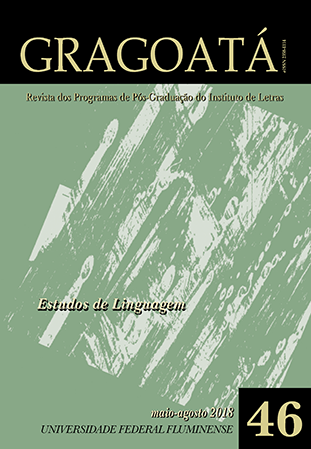The identity vitality of intonational contours typical of the "Manezinho" speech
DOI:
https://doi.org/10.22409/gragoata.v23i46.33593Keywords:
Intonation, Manezinho speech, Contours with upstep, Semantic-pragmatic value.Abstract
This article describes an intonational contour that typifies a dialectal variety of Brazilian Portuguese - “Manezinho” speech - and proposes the hypothesis of an interface between prosody and semantics/pragmatics, as the same intonational contour is interpreted with different meanings by “Manezinho” and non-“Manezinho” speakers. Seara e Sosa (2017), describing this “Manezinho” speech, identified a declarative contour with upstep in older speakers (over 50 years), that had not been yet described in the literature. This contour has an intonational nucleus with a very high peak followed by a drastic drop to the lower register of the speaker, represented phonologically as (LH) ¡H*L% in the Autosegmental-Metrical Theory (Pierrehumbert 1980, amongst other authors). This current research showed that although the younger speakers also use the contour with upstep, their version of it does not exhibit as high a rise as the ones produced by the elders. We conducted a discrimination test with contours with upstep similar to the ones of the older subjects, and by means of an identification test, we identified their semantic-pragmatic value. The discrimination test showed that the contour with upstep is widely used by the younger speakers, even if the rise is not as prominent as that of the older ones. The identification test showed that some prominent contours with upstep were identified by the non-Manezinhos as questions (17%); however, no Manezinho listener interpreted this kind of nucleus as a question. These results seem to suggest that we are facing two distinct varieties, which will require more in-depth analyses.
---
Downloads
Downloads
Published
How to Cite
Issue
Section
License
Authors who publish in Gragoatá agree to the following terms:
The authors retain the rights and give the journal the right to the first publication, simultaneously subject to a Creative Commons license CC-BY-NC 4.0, which allows sharing by third parties with due mention to the author and the first publication by Gragoatá.
Authors may enter into additional and separate contractual arrangements for the non-exclusive distribution of the published version of the work (for example, posting it in an institutional repository or publishing it in a book), with recognition of its initial publication in Gragoatá.

Gragoatá is licensed under a Creative Commons - Attribution-NonCommercial 4.0 International.














